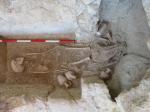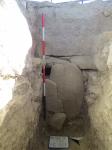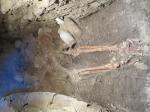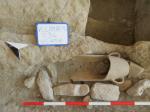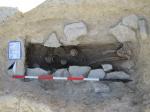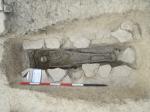Summary (English)
The excavation of tomb 35 continued from the surface layers: in fact it was seen that the primary pit for this burial had not been intercepted by the excavation of burial 1. What remained of the original covering for burial 2 was found and the burial itself was intact but without grave goods. Burial 2 covered the disturbed remains of burial 3, which may have been the first burial in the pit. Over the course of time, the pit may have contained four burials, if the disturbed remains of burial 1 and burial 2 are taken into consideration. The remains found in the surface dump belonged to other funerary contexts.
Tomb 1 is a vertical “pozzo”/shaft that provided access to two facing chambers created on the short sides of the “pozzo”, the only one in the Villamar necropolis. Chamber A and the “pozzo” were already investigated in the 1990s, even though the remains of some human long bones mixed with modern glass and plastic bottles were present on the bottom. Chamber B was probably not excavated at the time for motives linked to the state of preservation of the original context given that the chamber was almost completely filled by earth and stone blocks, although some modern disturbance was seen at surface level. In fact, as the sandstone ceiling of the chamber had collapsed, the excavation proceded from the ground surface of the necropolis, therefore from the exterior. An attempt had been made in antiquity to repair the ceiling using large stone blocks wedged with smaller stones, not so much to facilitate the chamber’s reuse rather the repair of the necropolis’s ground surface, which was not secure and could have been affected by further structural failure. Once the fill and large slabs from the ceiling had been removed from the chamber, the remains of the two original burials, of different date, emerged with their grave goods. The chamber’s collapse, which certainly occurred in the Punic period, prevented its repeated use, making it possible to get a better idea of some particulars of the funerary ritual.
Tomb 17 is a chamber with vertical “pozzo” sloping downwards, partially emptied, and refilled again, during the excavations in the 1990s. The “pozzo” presented lateral off-sets on which the covering slabs rested. The latter were found collapsed in the fill of the “pozzo”. The chamber was closed by a large stone slab supported by two smaller ones. Inside, the remains of the gave goods and unarticulated bones were recovered, but there was no primary deposition.
- Elisa Pompianu - Università degli Studi di Sassari
Director
- Elisa Pompianu - Università degli Studi di Sassari
Team
- Clizia Murgia – Università Autonoma de Barcelona
- Gabriele Carenti – independent researcher
Research Body
- Università di Sassari, Dipartimento di Storia, Scienze dell’Uomo e della Formazione
Funding Body
- Comune di Villamar





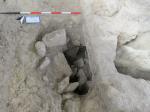
![Download [PDF]](/excavation/skins/fasti/images/results/download_sml.png)

